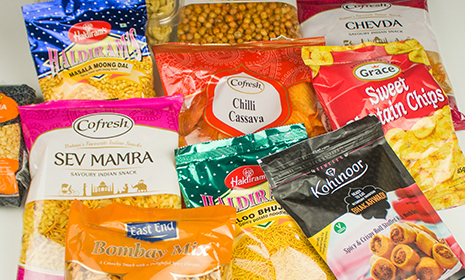
Snacks and diabetes
The diversity of snacks available in the UK continues to grow, reflecting their popularity and demand.
But, with so many options for quick and tasty nibbles, it's worth checking just what they mean for our health - and, crucially, are we eating too many of them?
Food is a way of caring for others in many cultures, with snacks and treats also featuring as an important part of many religious festivals, family celebrations and cultural habits.
Therefore, it can be difficult not to disappoint loving family members when we're presented with tempting treats - however, it's important to think about our health.
Background and family history
We know people from South Asian, Black African and African Caribbean descent are at higher risk of developing Type 2 diabetes at a younger age (25 years), and at a lower waist circumference, as below:
- 80cm (31.5 inches) for White, Black and South Asian women
- 90cm (35 inches) for South Asian men
- 94cm (37 inches) for White and Black men.
And, as our family history also plays an important role in our risk of Type 2 diabetes, it's important that everyone is making healthier choices when it comes to diet and lifestyle.
For those who have Type 1 or Type 2 diabetes, following a healthy, balanced diet - with only occasional treats - can reduce the risk of serious, long-term complications in the future.
We chose a sample from the diverse range of snacks at a local supermarket to cast the spotlight on exactly what they contain and how they measure up for fat, saturated fat, sugar and salt...
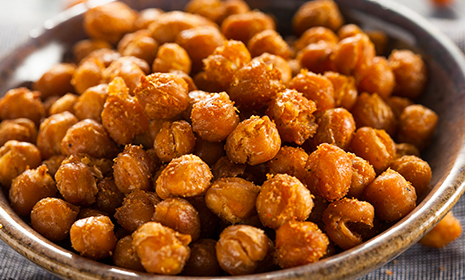
Portion size
Immediately noticeable, is the size of the portions included in such snacks. Many come in larger, 'sharing' sizes - varying from 200-400g.
Although we know that these packets aren't intended for a single sitting, once the packet is open, it can be difficult to resist temptation.
To avoid this common pitfall, try to measure out your portion before replacing the sealed packet high up in the back of a cupboard. If grazing is an issue, it's best to keep the snack out of reach and out of mind.
Ingredients
When it comes to colour-coded labelling on food packaging, we should all aim to choose:
Looking at the snacks we chose, you’ll notice that many are red or amber for fat and saturated fat. The ingredients list helps us to understand this; many of these snacks contain nuts, and, although the majority of these contain healthy unsaturated fats, they are high in total fat content – this bumps up the calories and makes it easier to gain weight.
Oils and fats
Also, many of the products contain oils - in relatively high amounts. Whilst some of them use vegetable oils such as rapeseed or corn oil, others use palm oil, which is high in saturated fat.
Saturated fat increases the amount of bad cholesterol (LDL) in the body, which can build up as fatty material in our arteries and is linked to higher risk of heart disease.
Saturated fat is found in animal products like butter, lard, cheese, meats and cream, but also in oils such as palm and coconut oil.
Unsaturated fats increase our levels of good cholesterol (HDL) which carries cholesterol back to liver where it is broken down.
Unsaturated fat is found in vegetable oils like olive, rapeseed, sunflower, corn and groundnut oils.
Salt
Many of the snacks were also high in salt. As salt is linked to high blood pressure, we should all be aiming to have no more than 6g per day. 75% of the salt of the salt we consume is from products purchased outside the home, so avoiding added salt in your cooking is not enough to stay under that target 6g per day. However, using alternative seasonings such as herbs and spices to add flavour certainly helps.
Fibre
Some of the snacks did contain slightly higher amounts of fibre at 5-6g/100g. Fibre is important for our gut health, and also helps to reduce blood cholesterol levels which, in turn, lowers your risk of heart disease. Having more fibre also helps to manage diabetes -fibre reduces the GI, which is a ranking of how quickly a food or drink will make blood glucose levels rise. Higher-fibre ingredients found in these products include nuts, lentils, chickpeas and beans.
Carbohydrates in snacks
There is a significant amount of carbohydrates in the majority of these snacks - even for one portion - and for those who count carbohydrates and adjust insulin doses, you need to take this into account when enjoying these types of snacks.
If you are eating similar snacks to these, it’s important to try and keep the portion size small, and not have them too often. But, as an occasional treat, they can be part of a healthy diet. If you fancy a change, also try some healthier alternatives:
Snack selection and results
*These nutritional values were accurate at the time of publication, but some of these values may have changed. Please check the food labels for the latest nutritional information.
Cofresh Chevda

| Per serving (28g) | Per 100g | |
|---|---|---|
| Calories | 154 | 549 |
| Carbs | 14.6g | 52g |
| Sugar | 1.7g | 6g |
| Fat | 9.2g | 33g |
| Saturated fat | 0.7g | 5g |
| Salt | 0.2g | 0.6g |
| Protein | 3g | 11g |
| Fibre | 1.7g | 6g |
East End Bombay Mix
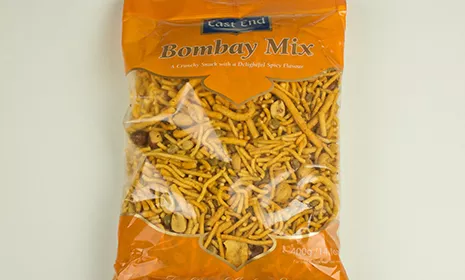
| Per serving (28g) | Per 100g | |
|---|---|---|
| Calories | 142 | 508 |
| Carbs | 8.9g | 31.8g |
| Sugar | 0.6g | 2.2g |
| Fat | 9.7g | 34.5g |
| Saturated fat | 1.2g | 4.4g |
| Salt | 0.3g | 1.1g |
| Protein | 4.9g | 17.6g |
| Fibre | 2.6g | 9.2g |
Cofresh Sev Mamra
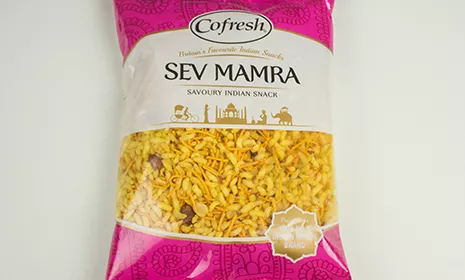
| Per serving (28g) | Per 100g | |
|---|---|---|
| Calories | 151 | 538 |
| Carbs | 15.9g | 57g |
| Sugar | 0.6g | 2g |
| Fat | 8.4g | 30g |
| Saturated fat | 0.8g | 3g |
| Salt | 0.3g | 1.1g |
| Protein | 2.8g | 10g |
| Fibre | 2.2g | 8g |
Cofresh Chilli Cassava
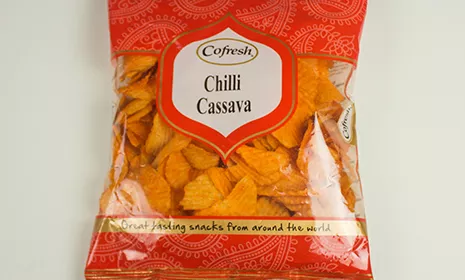
| Per serving (28g) | Per 100g | |
|---|---|---|
| Calories | 144 | 515 |
| Carbs | 19.4g | 69.2g |
| Sugar | 0.9g | 3.4g |
| Fat | 7.3g | 25.9g |
| Saturated fat | 2.4g | 8.7g |
| Salt | 0.2g | 0.7g |
| Protein | 0.4g | 1.3g |
| Fibre | 1g | 3.7g |
Haldiram's Masala Moong Dal

| Per serving (20g) | Per 100g | |
|---|---|---|
| Calories | 92 | 460 |
| Carbs | 10g | 51g |
| Sugar | 0g | 0g |
| Fat | 4g | 20g |
| Saturated fat | 0.6g | 3g |
| Salt | 0.3g | 1.5g |
| Protein | 4g | 20g |
| Fibre | Not stated | Not stated |
Grace Sweet Plantain Chips
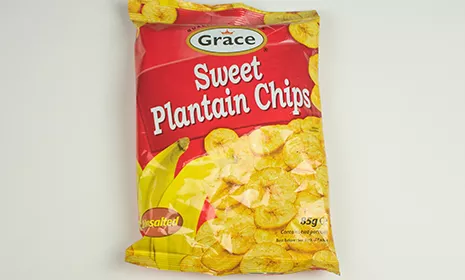
| Per serving (42.5g) | Per 100g | |
|---|---|---|
| Calories | 204 | 480 |
| Carbs | 27.7g | 65g |
| Sugar | 5.9g | 13.9g |
| Fat | 9g | 21.2g |
| Saturated fat | 4g | 9.4g |
| Salt | 0.11g | 0.25g |
| Protein | 1.7g | 4.1g |
| Fibre | 2.6g | 6.2g |
Haldiram's Aloo Bhujia
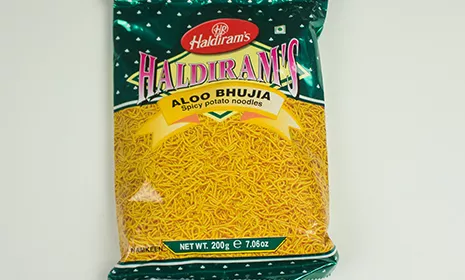
| Per serving (20g) | Per 100g | |
|---|---|---|
| Calories | 127 | 634 |
| Carbs | 8g | 40g |
| Sugar | 0g | 0g |
| Fat | 10g | 51g |
| Saturated fat | 2g | 10g |
| Salt | 0.3g | 1.6g |
| Protein | 1.2g | 6g |
| Fibre | Not stated | Not stated |
Cofresh Chick Peas
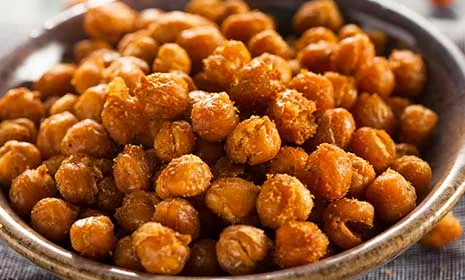
| Per serving (28g) | Per 100g | |
|---|---|---|
| Calories | 125 | 445 |
| Carbs | 17.4g | 62g |
| Sugar | 1.7g | 6g |
| Fat | 3.6g | 13g |
| Saturated fat | 0.3g | 1g |
| Salt | 0.2g | 0.7g |
| Protein | 5.6g | 20g |
| Fibre | 1.4g | 5g |
Kohinoor Bhakarwadi
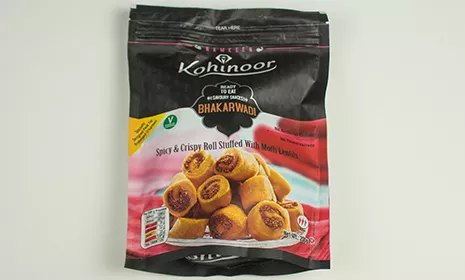
| Per serving (30g) | Per 100g | |
|---|---|---|
| Calories | 161 | 537 |
| Carbs | 15g | 50g |
| Sugar | 3g | 10g |
| Fat | 9.9g | 33g |
| Saturated fat | 3.6g | 12g |
| Salt | 0.5g | 1.7g |
| Protein | 3g | 10g |
| Fibre | 0.3g | 1g |
Port Royal Jamaican Jerk Chicken Patty
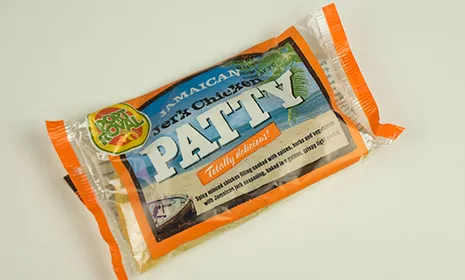
| Per serving (140g) | Per 100g | |
|---|---|---|
| Calories | 345.5 | 247 |
| Carbs | 39.3g | 28.1g |
| Sugar | 2.9g | 2.1g |
| Fat | 17g | 11.6g |
| Saturated fat | 7.4g | 5.3g |
| Salt | 0.8g | 0.6g |
| Protein | 9.5g | 6.8g |
| Fibre | 1.8g | 1.3g |
